July 2005: Berlin
Berlin, more so than most places, has seen a vast
amount of change in the course of my own lifetime. The city was
arguably the crucible of European history in the 20th Century and to
this day, even amidst the post-reunification excitement and
reconstruction, you can almost smell and taste that historical
legacy in the celebrated Berliner Luft. Just as new buildings
have been springing up everywhere in a bold expression of hope for a
better future, so too, with almost predictable regularity, the
restless ghosts of the old century resurrect themselves to make
their mark on the visitor's senses. It's that kind of place :
exciting, thought-provoking and occasionally disturbing, all in one
heady mix.
I had visited Berlin on two previous occasions :
first, in 1982, with the city cruelly partitioned and the Cold War
showing no signs of any let-up; and secondly in 1997, with the wall
not just down, but seemingly in the process of being physically
expunged from the city's fabric, as Europe's biggest building site
got ready for the restoration of its status as the seat of
government of a united Germany. Another eight years on, and with the
initial round of rebuilding presumably over, I decided it was time
to go back for another look.
Tiergarten district
 |
Originally constructed in front of the
Reichstag to commemorate Prussian victory against the Danes,
the Siegessäule was moved to its present site at Großer
Stern by the Nazi regime.
|
 |
On the first day of my visit, the Siegessäule marked the
starting point of a 'Herbie' rally of Volkswagen Beetles.
|
 |
This Arts Centre, celebrating the diversity of world
cultures, was jointly built by Germany and the USA. It is
regarded as a symbol of the friendship between the two
countries.
|
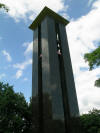 |
Berlin's Carillon, the largest in Europe, was built in 1987
to mark the city's 750th anniversary.
|
 |
I think the Reichstag looks superb with its new dome. It is
now, of course, the home of the German Parliament.
|
 |
The top of the dome is open at the centre. Those wanting to
take in the magnifcent views can either lean on the rail or
have a rest on the circular seat.
|
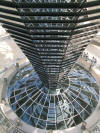 |
The impressive support for the viewing platform.
|
 |
Gently sloping, dual walkways wind their way around the
inside of the dome.
|
 |
The Brandenburg Gate and the reconstructed Pariser Platz, so
recently part of the infamous death strip.
|
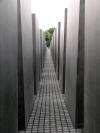 |
The Holocaust Memorial or,
more correctly, Memorial to
the Murdered Jews of Europe. This controversial new memorial
lies between the Brandenburg Gate and Potsdamer Platz. |
 |
From the busiest urban hub in Europe, to the middle of No
Man's Land, to one of the most prestigious addresses in
Berlin. Potsdamer Platz is again a transport interchange,
prime office location and centre of entertainment.
|
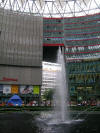 |
The Sony Center is a popular gathering place for movie-goers
and diners alike.
|
Mitte district
 |
The
Museum of German History is just one of many fine buildings
on Unter den Linden. |
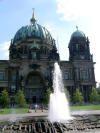 |
Confusingly, Berlin has at least four church buildings
within a few hundred metres of each other, all claiming to
be cathedrals. Undoubtedly the most impressive is the
Lutheran Berliner Dom.
|
 |
The Old
Museum is situated next to the Berliner Dom on the rather
theme park-sounding Museum Island, a world heritage site. |
 |
The Old National Gallery is
one of the most popular
museums on Museuminsel. |
 |
The Bodemuseum, currently under restoration, sits at the
northern tip of Museuminsel. The TV Tower at Alexanderplatz
is clearly visible in the background.
|
 |
Neue Wache, Unter den
Linden. The walls and floor have been re-lined to obliterate
DDR symbols, while the flame that once burned here has been
replaced by an enlarged copy of Käthe Kollwitz's Pietà. |
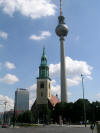 |
The Marienkirche in Alexanderplatz is dwarfed by the TV
Tower, built in 1969.
|
 |
Alexanderplatz - Alex to all Berliners - was the stern and
unattractive focal point of the old East Berlin. It is now a
much more pleasant place. Here we see the Marienkirche and
the Neptune Fountain.
|
 |
Much of the grim communist architecture in Alexanderplatz
has been torn down and replaced by something a little more
stylish and colourful.
|
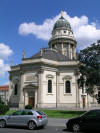 |
The Gendarmenmarkt contains the twin Deutscher Dom and
Französischer Dom, neither of which is actually a church!
Destroyed in the war, they have been restored as museums.
|
 |
Originally a theatre, the concert hall sits between the
German and French "churches" in the Gendarmenmarkt.
|
 |
The TV Tower gives stunning views all the way from
Museuminsel to the Tiergarten and beyond.
|
Remains of the Wall
 |
I discovered this surviving section of the wall not far from
Potsdamer Platz. Some local artists have made their message
clear. Love the Trabbi!
|
 |
A preserved section of the wall sits above the excavated
cellars of the former headquarters of the SS.
|
 |
Compare this view of Checkpoint Charlie to my 1982 photo,
when it was for real! The site is now basically a tourist
atraction. |
 |
A (fake) American soldier poses for pictures, while the much
expanded Haus am Checkpoint Charlie museum is clearly
visible in the background.
|
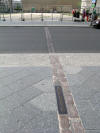 |
In some locations, the former line of the wall is marked by
cobblestones.
|
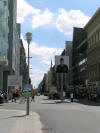 |
Checkpoint Charlie, from the Russian Sector. |
Other areas
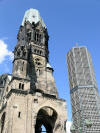 |
At one end of what was once West Berlin's most celebrated
street, the Kurfürstendamm (or Ku'damm). The original
steeple was left in this state as a deliberate reminder of
what war means. The modern replacement is quite a contrast.
|
 |
Happily now just a memorial ... so close, but never
touching.
|
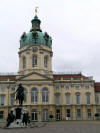 |
Charlottenburg Palace - another triumph of restoration,
following near-destruction in WWII. |
 |
The palace has extensive and impressive grounds.
|
|
|
|
|

































